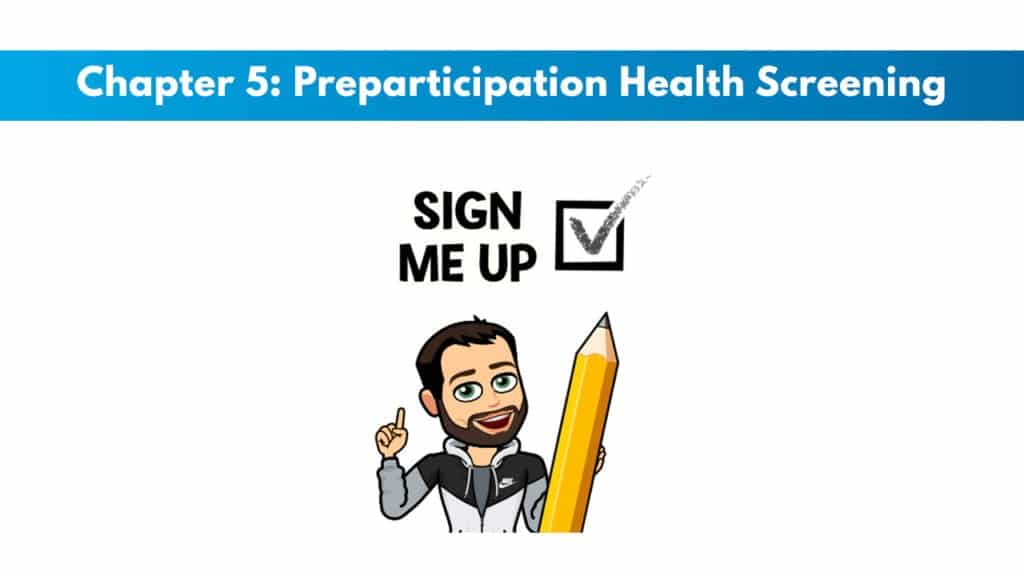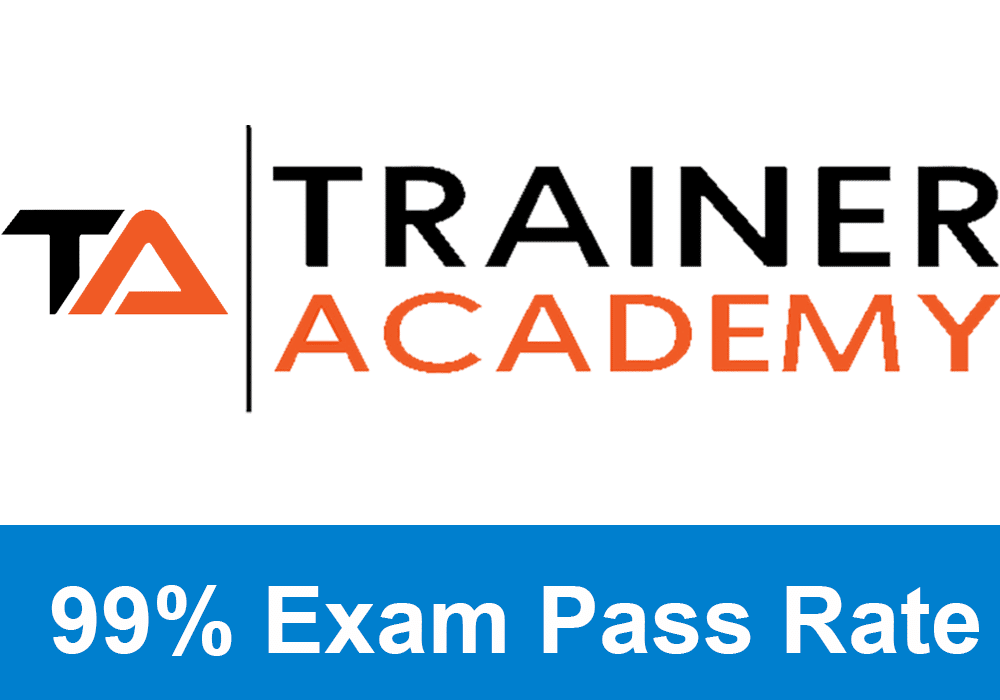
If you have not yet signed up for the ACE CPT certification, receive a big discount here.
Get your copy of the ACE CPT exam cheat sheet.
It helps immensely in your ability to study for the ACE test. This PDF printable one-page sheet gives you a breakdown of the skills and knowledge candidates need to pass the exam.
My PTP students report cutting their ACE study time and effort in half with Trainer Academy.
Benefit from the Exam Pass Guarantee and Retake Fee Guarantee. Plus, take advantage of my current discount code PTPJULY for 35% off the MVP Program (Ends July 9th, 2025).
Try it out for free here to see if it’s right for you, or read my detailed review for further insights.
Chapter Goals:
- Be able to administer the exercise participation health screening for your clients.
- Know what scenarios look like where a client needs further evaluation from qualified healthcare providers before them starting or increasing their physical activity.
- Find the additional forms that need to be completed by clients to make sure they have a successful exercising experience.
Introduction
Before the trainer begins to develop that initial rapport with the client so that they can get the individual needs, goals, and interests, the trainer must go through a rather thorough process of preparticipation health screening to help ensure the client is mentally and physically ready to undertake a new exercising regimen.
Exclusive PTP CPT Offers |
||
|---|---|---|
Most Popular Cert | Best Online NCCA Cert | Best Study Materials |
Gold Standard Cert | A Good Option | Best CPT for you?  |
This information, along with the stated goals and the assessments chosen, will all come together and be used for making a specific program for the client.
Inherent Health Risks with Exercise
Research shows that physical activity’s positive impact will reduce someone’s risk of developing diseases and certain forms of cancer, anxiety, depression, and premature death.
The importance of finding these risks exists because there are many problems with types of exercise when we look at underlying conditions like cardiovascular disease and the many other potential underlying condition forms.
CVD is one of the major risk populations that exist. Here we see exercise relating to acute myocardial infarction and sudden cardiac death with significantly higher risks.
Some further considerations may come up as far as if an exercise program can be self-directed or must always have the trainer giving supervision for safety.
Preparticipation Health Screening
The preparticipation guidelines within the ACSM are made to remove any unnecessary barriers to becoming more physically active.
The profiling of risk factors or the classification of individuals is not within this screening process as there is insufficient evidence for giving these out.
The new process for health screening is based on three main factors:
- The current level of physical activity for the individual.
- The presence or some signs of any diagnosed disease or some symptoms for cardiovascular, renal, or metabolic disease specifically.
- The level of intensity that is desired for the program.
The screening process will then work to recommend medical clearance when needed. The goal of this process is to find people who:
- They should receive medical clearance before initiating an exercise program or increasing some variables of the program they are currently in.
- Have clinically significant diseases and may also benefit from a program that will be medically supervised.
- Have medical conditions that might need to be excluded from programs until they are resolved or simply under control by the client.
The interpretation of the signs and symptoms may sometimes be within the scope of practice for the personal trainer, but sometimes it should come from some other medical professional. This is seen with things such as:
Exclusive PTP CPT Offers |
||
|---|---|---|
Most Popular Cert | Best Online NCCA Cert | Best Study Materials |
Gold Standard Cert | A Good Option | Best CPT for you?  |
- Pain or discomfort in the chest, jaw, arms, or other bodily places may come from myocardial ischemia.
- Shortness of breath when resting or only mildly exerting effort.
- Orthopnea or paroxysmal nocturnal dyspnea.
- Dizziness or syncope due to lessened perfusion to the brain.
- Ankle swelling occurs.
- Palpitations or tachycardia.
- Intermittent claudication.
- A known heart murmur.
- Unusual fatigue or shortness of breath with typical activities.
Self-guided Screening
Preparticipation health screening for people who wish to start an exercise program should start with the PAR-Q+.
This form is evidence based and was made to reduce the number of unnecessary barriers to exercise.
This form may be used as a tool for self-guided screening or as an additional element of screening for use by a personal trainer when they are seeking client information.
The PAR-Q asks the client to answer 7 yes or no questions, and if they have answered no to all of the questions, then they are cleared for activity. If they answer no, then they will require more screening and forms to see further if they need clearance first.
The PAR-Q+ adds a bit to these questions to dive further into the client’s health and decide if they need more forms.
Additional Forms
During the preparticipation health screening process, the need for an outside referral will have been decided. Once the client is clear about starting an exercise program, then an appropriate plan will be made.
Beyond that PAR-Q or the preparticipation health screening, we have several important forms for trainers to be informed about.
The Lifestyle and health history questionnaire is one of these. This form collects more details into the medical and health information, and specific information that involves past and recent experiences with physical activity, medications or supplements that are being taken, recent or current illness or injury, surgeries, and past injuries, family medical history in general, and lifestyle information with things like sleep, nutrition, work, and stress.
The Medical Release form is an additional form that gives the trainer the client’s medical information and explains to the trainer the physical limitations or other guidelines that the client’s physician lays out. Any deviations from these will need to be approved by the physician.
Medications
Medications or other substances are important to us as trainers, as these substances will affect the body and the client’s overall ability to perform or respond to exercise. The trainer must understand the drugs’ properties and discuss them with the client so they have some understanding.
This can be a tough subject to master for trainers, as there are thousands of names for the substances that are out there, and it’s good to break these down into categories.
These drugs will be put into the broader categories of beta-blockers, antihistamines, or bronchodilators.
It is important to go through the many subcategories of drugs in the table in this chapter, as there are many responses the body has for these drugs.
Antihypertensives
High blood pressure, also known as hypertension, is very common in today’s society, and many forms of medication can be used for its treatment.
Many of the antihypertensives will affect one of these sites: the heart, the peripheral blood vessels, the brain, or the kidneys. The site on which the medication works will help determine its effects.
Be sure to know the beta-blockers, calcium channel blockers, angiotensin drugs, and diuretics that affect the body.
Bronchodilators and cold medicines are other forms of drugs that will affect the body.

 Have a question?
Have a question? 



Tyler Read
PTPioneer Editorial Integrity
All content published on PTPioneer is checked and reviewed extensively by our staff of experienced personal trainers, nutrition coaches, and other Fitness Experts. This is to make sure that the content you are reading is fact-checked for accuracy, contains up-to-date information, and is relevant. We only add trustworthy citations that you can find at the bottom of each article. You can read more about our editorial integrity here.